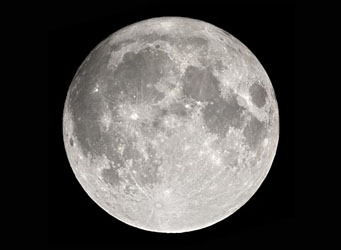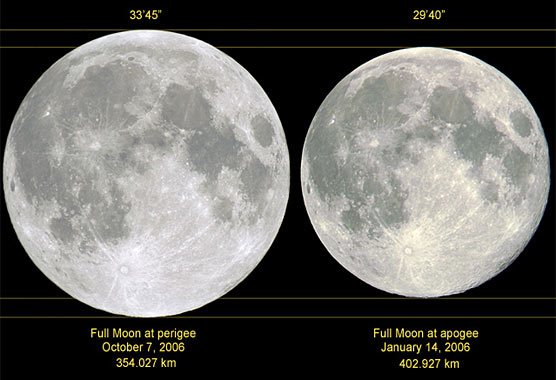There's no telling what the world will get excited about. Amid the catastrophe in Japan, the Libyan and Yemeni crises and everything else, a lot of the news media and the internet, it seems, are eagerly awaiting Saturday's "supermoon." It's being billed as the closest and biggest full Moon in 18 years.

When the Moon is full, its craters, mountains, and other surface features appear muted because the high Sun casts no shadows as seen from our earthbound perspective.
Gary Seronik
It's true. The Moon is full on March 19th right about when it's at perigee, its closest to Earth in its monthly orbit. And not all perigees are precisely the same. This one is a trace closer than usual.
But not by enough to notice.
There's something that many people (and too much of the news media) never seem to grasp: When it comes to science stories, if you don't know it in numbers, you don't know it at all.
How much bigger is this month's full Moon? Here's the number. It's just 2% bigger in diameter than the full Moons of last month and next month. That's one part in fifty. You couldn't tell the difference if you put them side by side.
Big whoop.
There is, however, more to the picture. The difference between the Moon at perigee and apogee, its farthest from Earth each month (just two weeks before and after every perigee), is roughly 14%, quite noticeable in a side-by-side comparison as shown below. But when the Moon is up in the sky and there's no comparison at hand, even that much difference is hard to detect.

The full Moon at perigee and apogee.
Laurent Laveder
The takeaway message from all this? Astronomy stories inspire people to look up and consider the larger universe, but they can also educate in practical ways for getting through life. The "supermoon" flap is a harmless bit of hype. But when your relatives start sending you frantic chain letters about the Japanese nuclear fallout starting to "pound the West Coast," like one blog post I've already seen going around, remember what you read here:
When it comes to science stories, if you don't know it in numbers, you don't know it at all.
Look at the numbers for the radiation reaching the West Coast. You'll see that it's trivial compared to the natural background radiation that everyone receives every day.
So don't let anyone tell you that you can't learn anything practical from astronomy. Send your frantic aunt this article.
 17
17
Comments
flow
March 18, 2011 at 5:14 pm
its seems there are two poles to this debate, the over-reacting disaster crew, and the over-compensating denial crew.
2% is a lot. if your mortgage interest went up by that much, you'd be howling, and if you got that much fatter, you'd cry.
lets be honest here. 'tidal forces', or distortions in the gravity well, have a deep and profound effect on the earth. it is true that this coming 'supermoon' is really no more than a localised maxima in a constantly oscillating pattern, but it is still a mzxima. couple it with increased sunspot activity (proven to correlate with tectonic effects) and you have a change in the odds.
betting on long odds is a funny game, but how many of us wear seatbelts?
You must be logged in to post a comment.
pikelet
March 18, 2011 at 7:43 pm
It's all very well being specific, I'm all for it, but what do you mean by 'bigger' - diameter? area? How much bigger, in angles, would the moon be? How much brighter?
Plus you need to take into account how the human perceptual syatem works.
You must be logged in to post a comment.
Kevin
March 18, 2011 at 8:57 pm
"proven to correlate with tectonic effects"
Sources please; preferably not something citing a "2012 end of the world scenario"; Thanks.
Kevin
You must be logged in to post a comment.
RobLAL
March 19, 2011 at 4:43 am
I was confused because I thought I remember learning from Jack Horkheimer that the full moon in either October or November was the closest to the Earth. Although, it's been a long time since I heard that. Can anybody clarify?
You must be logged in to post a comment.
Alan Clark
March 19, 2011 at 5:15 am
There are several factors that determine the brightness of the full moon. One is the distance of the sun - we are closest in January, so the very brightest full moons occur at that time of year.
Another factor is the phase angle of the moon. The full moon can be 5 degrees from the anti-solar point when full, which reduces the brightness significantly, and that is the case for this full moon.
So this will not be particularly bright, and it was brighter on 2001 Jan 9, just before and after it was eclipsed, so the figure of 18 years is wrong.
For a discussion of the brightness of the moon see "More Mathematical Astronomy Morsel" by Jean Meeus.
You must be logged in to post a comment.
Tom Sales
March 19, 2011 at 7:25 am
I still receive breathless emails every August from friends who ask, "Is it true that Mars is going to appear as big as the moon on August 26th?"
And every year I tell them:
1. This was an event that happened in 2003.
2. At that time, Mars only looked as big as a full moon IF you viewed the planet through a 100 POWER TELESCOPE!
It doesn't make any difference; they send me the same message the following year. It's sort of become an August tradition for me.
You must be logged in to post a comment.
Robert Taylor
March 19, 2011 at 9:39 am
@Tom Sales
I still get those fake emails about Mars being as big as the Moon too. Yes if you look at it through a telescope it might seem bigger, but never as big as the moon.
You must be logged in to post a comment.
Elaine
March 19, 2011 at 4:34 pm
My husband and I were outside last night. We live in a very rural area and have for a long time. The moon was so bright last night we could see the livestock in the farm next to us after midnight like it was the middle of the day. For us this is odd. So odd, my husband noticed it. I am the one who loves astronomy, not him. So it's quite brighter. Interested in knowing the difference in brightness with this "Supermoon" as oppossed to other Full Moons, and how much stronger will high and low tides be?
You must be logged in to post a comment.
pikelet
March 19, 2011 at 6:00 pm
Sorry, now my computer has deigned to load the page properly I see you had included some of what I asked.
Moon looked noticeably brighter here in England last night and tonight.
You must be logged in to post a comment.
pikelet
March 19, 2011 at 6:06 pm
Moon noticeably brighter last night and tonight.
Page has now loaded properly, and the two moon comparison goes some way to answering what I put!
You must be logged in to post a comment.
Elaine
March 19, 2011 at 7:54 pm
Just got my first peak of the "Supermoon". Can anyone tell me why it's coloring is similar to that of the Hsrvest Moon? It is different then the Harvest Moon, eerriee...as I watch it rise this yellow/orange color is fading. Why did it start it like that, and why is the coloring going away now? Is anyone else seeing this, or just me? I am in the United States. Thanks for your response Pikelet! Good luck with your picture!
You must be logged in to post a comment.
David Fried
March 19, 2011 at 8:19 pm
alan Clark, could you say a little more about the brightness issue? If this perigee moon has an apparent diameter 14 percent larger than an apogee moon, the surface area we see is 26 percent larger. That's simple geometry. But is it 26 percent brighter, setting aside the factor you mention--its distance from the ecliptic?
I keep reading this "supermoon" will be 30 percent brighter. Are these writers just rounding up, or is something else in play? I know that a quarter moon is not half as bright as a full moon, but about a tenth as bright, because of the different angle of incidence of the sunlight relative to us.
Comment?
You must be logged in to post a comment.
Calvin
March 20, 2011 at 11:28 am
This is a magazine about science. If we are going to post about numbers, we should make sure our numbers are right. The comment saying that you would howl if your interest rate went up by two percentage points. This is true because if, for instance, your rate went from 5% to 7% it would be a FORTY percent increase (2/5x100=40). If, on the other hand, your rate actually went up by 2%, it would go to 5.1% (5x1.02=5.1). Probably not worth a howl.
You must be logged in to post a comment.
James West
March 20, 2011 at 12:12 pm
I posted this on Flickr: http://www.flickr.com/photos/ejwwest/5542391845/
It overlays last November;s Full Moon with that yesterday.
You must be logged in to post a comment.
Mike
March 20, 2011 at 3:32 pm
I'm sorry, but most people won't notice a 2% change in values unless it's pointed out to them. Your own example pretty much proves it: 2% of 150 lbs is 3 lbs. If you've ever been on a diet, you know that your weight changes by significantly more than that during the day - which is why people watching their weight are told to weigh themselves at the same time every day. Most people not only don't cry about this, they don't even notice it.
You must be logged in to post a comment.
Jed
March 20, 2011 at 4:07 pm
What a short memory we have! I took a picture of last night's moon and then looked through my archives to find a comparison. I found the full moon of January 30th, 2010. The image size of that moon was slightly larger than the one I took last night (using the same lens and camera). So I searched for news articles from January 2010 and found articles hyping up the biggest moon of 2010, with the exact same numbers! It was to be 14% larger and 30% brighter. Turns out the distance of the full moon in January 2010 was only 12 miles farther away from us than last night's full moon. I don't think the news media could have hyped up last night's super moon if they had made a reference to a full moon of just over a year ago, that was only 12 miles more distant.
You must be logged in to post a comment.
John Sheff
March 20, 2011 at 4:28 pm
So, Alan, YOU put a number on it. Just how big, in minutes and seconds of arc, was last night's Full Moon? You have those images of the Moon from 2006, and you tell us the Full Moon yesterday was about 2% bigger than preceding and following Full Moons, but you never tell us just how biog last night's was! Numbers, please!
You must be logged in to post a comment.
You must be logged in to post a comment.